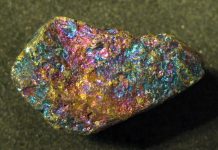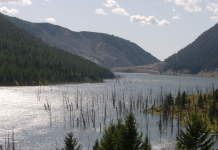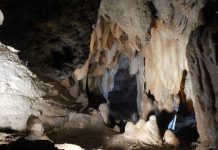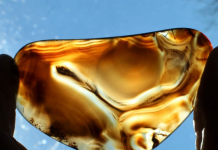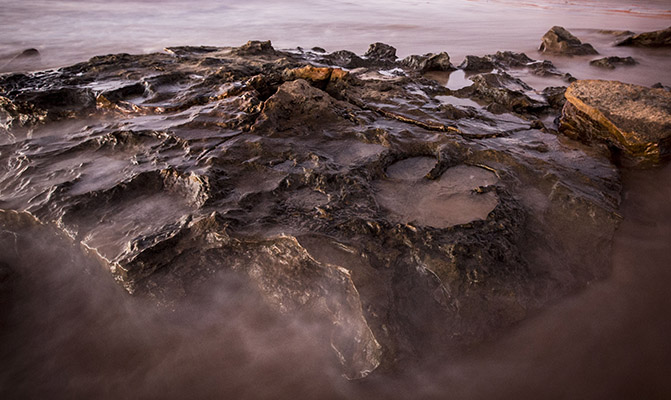
by Steve Voynick
The indigenous Goolarabooloo people have long been intrigued by a trail of 3-foot-long footprints embedded in solid sandstone on Australia’s remote northwest coast. These aboriginal Australians believe that the three-toed prints and related drag marks that seemed to be have been made by a heavy, feathered tail had been left behind by their creator spirit Marala, or “Emu Man”. For thousands of years, these footprints and drag marks, along with their assumed origin, have been part of Goolarabooloo oral tradition, which recounts how Marala gave the people rules to live by and guidance in keeping their world in balance.
But in 2008, Marala’s footprints, located on a shoreline 25 miles north of the city of Broome in Western Australia, an area that the Goolarabooloo know as Walmadany, were threatened by the proposed construction of a huge liquid natural gas processing plant. To help oppose the project, the Goolarabooloo community invited scientists to document Walmadany’s natural resources.
Among them were paleontologists from the University of Queensland’s School of Biological Sciences and James Cook University’s School of Earth and Environment. At the place where the Goolarabooloo people pointed out Marala’s footprints, the paleontologists found thousands of dinosaur tracks. Because of these tracks and other irreplaceable natural features, Australia’s national government awarded the area National Heritage status in 2011, forcing developers to abandon their plans to build the plant.
Investigating these dinosaur tracks, spread along 15 miles of shoreline, took five years. The work was unusually difficult because many tracks were exposed only at low tide. Nevertheless, the team photogrammetrically documented hundreds of tracks, photographing each from different angles so that they could be three-dimensionally recreated. The scientists also used a flexible-silicon medium to make casts of the best-preserved tracks, so they could replicate them precisely for museum displays.
The Walmadany tracks have proved to be a record of the most diverse dinosaur community ever discovered. They represent 21 distinct types of dinosaur ichnofauna (dinosaur types known only from their tracks): seven predatory carnivores; six long-necked, herbivorous sauropods; four quadrupedal, herbivorous ornithopods; and four armored dinosaurs. Other tracks provided the first evidence of the presence of stegosaurs (dinosaurs with prominent dorsal plates and spines) in Australia.
The impressions left by one particularly imposing, long-necked sauropod measure nearly 6 feet across and are by far the world’s largest known dinosaur tracks. The animal that made these remarkable tracks stood an estimated 18 feet tall at the hip.
When the Walmadany tracks were made 130 million years ago, during the early Cretaceous Period, Australia was not the arid land that it is today. It had just separated from the Gondawana supercontinent and, with a warm, moist climate, was largely covered by conifer forests and profuse growths of ferns and other plants that supported a large and varied dinosaur population.
Walmadany was then a vast river plain of tidal deltas, estuaries and creeks, surrounded by lush conifer forests. Great numbers of dinosaurs of all sizes and types regularly traveled across wet, sandy areas that separated the forests.
“There would have been dinosaurs walking all over this coastline,” says Dr. Steve Salisbury, a paleontologist at the University of Queensland and the leader of the team that documented the tracks. “It must have been quite a sight.”
Walmadany has additional importance because most of Australia’s known dinosaur tracks are on the eastern side of the continent and are considerably younger. The Walmadany tracks are Australia’s oldest dinosaur remains and constitute its only fossil “window” into the early Cretaceous Period.
While paleontologists know the Marala footprints are those of a three-toed, carnivorous dinosaur now named Megalosauropus, the Goolarabooloo people continue to see them in their traditional way as the timeless footprints of their spirit creator “Emu Man”—which are now protected forever from commercial development.




